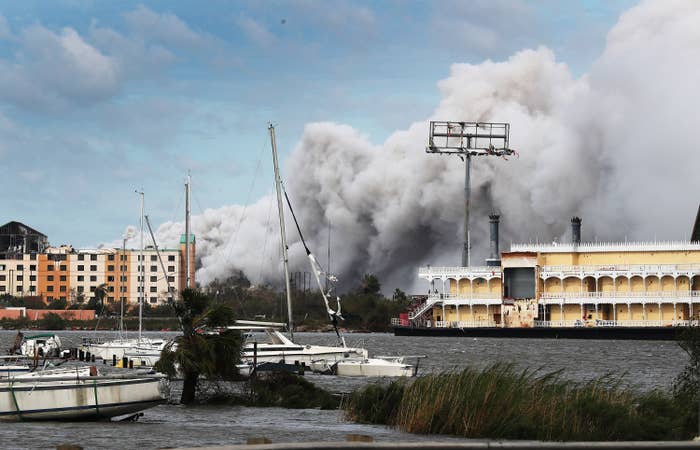
Hours after Hurricane Laura ripped through Lake Charles, Louisiana, its wild winds smashing glass and snapping trees, the misery compounded when a chemical plant burst into flames, prompting Gov. John Bel Edwards to order an area home to 35,000 people to shelter in place to try to avoid the toxic fumes.
"If you are in the Westlake/Moss Bluff/Sulphur area, shelter in place, close your windows and doors and TURN OFF YOUR AIR CONDITIONING UNITS,” Gov. Edwards tweeted around 10:45 a.m. local time. “There is a chemical fire. Stay inside and wait for additional direction from local officials.”
Environmentalists, who have long worried about the petrochemical plants lining the Gulf Coast, worry it is just the beginning of the environmental toll. Volunteer air groups, meanwhile, said the fire had hampered their rescue efforts, preventing many from going into the area.
“We are doing everything we can to get that situation under control,” the governor said at a press conference Thursday afternoon. But he stressed that residents needed to keep their air conditioners off and their doors and windows closed, despite the heat.
Throughout the morning, local reporters and volunteers in the area uploaded video to social media of thick, dark smoke billowing out of an industrial area in the town of Westlake, just west of Lake Charles. The town is home to a number of oil refineries and petrochemical plants, including several facilities that have long histories of fires, spills, and environmental violations.
State officials confirmed one fire at a chlorine plant owned by BioLab, a Georgia-based chemicals manufacturer. Local journalists, pointing at a second, separate plume of smoke, suggested there could be a second fire, but its source was unconfirmed Thursday morning.
The BioLab facility manufactures chlorine cleaning products for swimming pools and spas and is located just across Interstate 10 from the city of Westlake, which has a population of 4,600. Some homes are only about 1,200 feet from the edge of the complex.
Chlorine in concentrated doses can damage the lungs. Guidelines from the National Institute for Occupational Safety and Health at the CDC recommend that during a fire, officials evacuate people within a half-mile radius. But with many local roads still unnavigable due to the damage caused by Hurricane Laura, officials instead ordered residents to shelter in place.
The facility had recently been cited for violating the Clean Water Act, including for releasing hexachlorobenzene, which the EPA classifies as a probable human carcinogen.
The scenario is exactly what some environmentalists had feared. As Hurricane Laura prepared to make landfall earlier this week, scientists had worriedly eyed the Gulf Coast, which is home to more than 60 refineries and petrochemical plants in the storm’s path. EPA data shows that 32 of those facilities are currently tagged with significant violations of one or more of the nation’s environmental laws.
The region has seen this before. Following Hurricane Harvey, which slammed into Houston three years ago, oil refineries and petrochemical plants in that storm’s path took a direct hit, collectively releasing hundreds of millions of gallons of toxic wastewater and more than a million pounds of toxic air contaminants. Noxious chemical compounds, including heavy metals and volatile organic compounds, were later found in the soil of nearby homes.
Many fear this time around could be just as bad, if not worse. That means that even after the storm waters recede, people could be facing threats to their health from chemical spills, runoff, and air polluted by volatile organic compounds, according to some scientists.
“Every time we see a major storm hit this area, we see spills and chemical releases, and the path and strength of this particular storm really worries me,” said Gretchen Goldman, research director at Center for Science & Democracy at the Union of Concerned Scientists. “Around Port Arthur in Texas, Harvey damaged facilities and led to accidental toxic releases in the community and the community saw health effects from it, and it's going to be those same facilities and those same communities exposed this time. It's like it's just going to go on repeat. It's very predictable, but very preventable.”
Brianna Sacks contributed reporting to this story.
